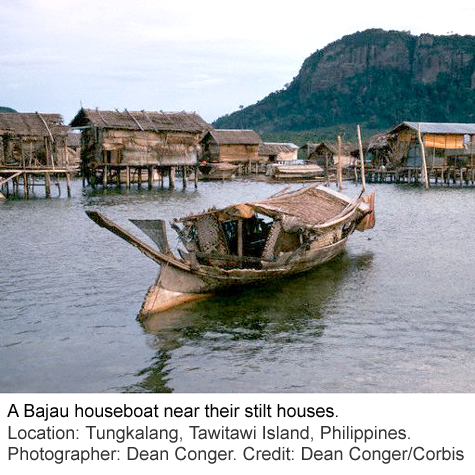
Bum-Bum Islands - Lepa origin :
Updated on Monday, 16 April, 2018 11:23:26 PM
SABAH > TAWAU DIVISION > SEMPORNA TOWN > Regatta Lepa-Lepa > LEPA BOAT
THE TRADITIONAL LEPA BOAT

Bum-Bum Islands - Lepa
origin :
LEPA boat is believed to be originated from the Pa'alau Bajau people who live in Bum Bum Island and used by fishermen along the coast of Semporna. The unique lifestyle and festival is a cultural legacy inherited by many generations.
Traditional Lepa vs Modern Lepa

A Bajau houseboat near their stilt houses.
Location: Tungkalang, Tawitawi Island, Philippines.
Photographer: Dean Conger. Credit @ Dean Conger/Corbis

A decorated modern Lepa boat near SEMPORNA
OCEAN TOURISM CENTRE
during 13th Regatta Lepa 2006
2006-04-16 SUN 14:12

The Lepa-Lepa is slowly carving out new perspectives of today. A boat that once only knew dayungs (paddles) is now fitted with a modish motorized engine.
For the Bajau people, Lepa boats are multi-utility. The boat serves as a fishing vessel and as a means of transportation. It is also utilized for wedding venues and cultural performances. The unique lifestyle and festival is a cultural legacy inherited by many generations.
The Lepa-Lepa is made out of ubar suluk (red seraya) wood found on the islands. No other wood can be used to make this boat.
The Lepa-Lepa generally measures 25 feet in length and six feet wide. The distinctive design of Lepa-Lepa is shaped to mimic the figure of a fish.
This form lends the boat a smooth glide when it rolls with the waves. It has been said that there has been no Lepa-Lepa that has ever sank, crediting this innovative design.
What was once seen swarming the shorelines is only taken out to sea on occasion such as Regatta Lepa. The skills that were mastered by fathers are no longer passed down to the children. Men who lived on their skills of making a Lepa-Lepa now look to the new ecotourism industry.
The tradition is regrettably and slowly heading down the road to extinction. New
pressures and challenges of today perhaps daunt the minds of the simple folk
here. However, many still believe that this is a bequest so peerless it must
persist. Celebrations like the Regatta Lepa commemorates this heritage in hopes
that they will carry on burning in the hearts of their people, old or young and
will pass on for many generations more. Change will inevitably come, but the
Bajau will nonetheless fight to salvage what little is theirs. The richness of
Bajau heritage is starting to be recognized as worthy of preservation.

https://nuspress.nus.edu.sg/products/the-sulu-zone
The Sulu Zone: The Dynamics of External Trade, Slavery and Ethnicity in the Transformation of a Southeast Asian Maritime State, 1768-1898
‘Lepa’ is a Bajau language means a wooden boat used by the Bajau
community mostly in Semporna, the Southern part of Sabah, Borneo Malaysia. The
boat is made of solid wood called ‘Ubar Suluk’ and sometimes ‘Seraya Merah’,
Lepa has been used as the main transportation since over a centuries ago by the
Muslims travelers and traders.
Lepa boat are made mostly by the people of Nusalalung village at Bum-Bum
island nearby Semporna, and it believed that this island is the origin of where
Lepa boat came from. A typical Lepa boat usually measured around 5 meters long
and 1.5 meters wide, it comes with a tall and sharp head on the front which
called ‘tujjah’ and usually comes with two types of sail called ‘lamak bua’an’
(bigger sail) and ‘lamak kapi’ (smaller sail). Lepa boat also attached with a
small house placed in the middle of the Lepa boat body, this small house comes
with a palm leaf roof .